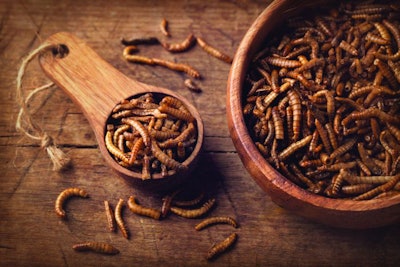
Insect protein has been making a big splash in the pet food and human food worlds for several years now. Though still a nascent category of pet food ingredients—according to Mintel data, insect protein claims account for less than 1% of global pet food product launches—its potential to serve as an alternative protein source, alleviating shortages of other protein ingredients as well as promising to be more sustainable, has captured a lot of attention, curiosity, investment, research and media coverage (including by this website and our related publications and conferences).
What is the category’s potential? Is all this attention, even hype, warranted, or is insect protein destined to be just a fad?
Why so many are bullish on insect protein
I confess to being intrigued by, if not bullish on, insect protein. It just seems to tick so many boxes, especially in terms of sustainability. Besides using much less land, water and other resources compared to traditional animal proteins, most commercially raised insects are fed “upcycled” material from the human food supply chain—for example, produce past its sell date or parts of fruits, vegetables and other foods not typically sold to or consumed by humans.
Also, research into insect protein’s nutritional benefits and safety levels for pets is growing, showing good results in terms of palatability, digestibility and safety, according to study results presented by Brad Ewankiw, product line manager, feed, for Enterra, during Petfood Forum 2022. Those data were specific to black soldier fly larvae (BSFL), but similar research is happening and being published on cricket and mealworm protein.
As for the so-called yuck factor—the belief that people in Western cultures aren’t accustomed to eating insects and turned off by the idea, and with humanization, that attitude might well extend to what they feed their pets—it may be waning. Ewankiw’s presentation also included results of an Enterra survey of North American pet owners: 55% were very or somewhat interested in purchasing pet diets with insect protein after receiving a brief education about it (compared to 42% pre-education), versus 36% and 23%, respectively, in 2020.
Similarly, at Petfood Forum Europe 2022, Kate Vlietstra, associate director for Mintel Food and Drink, reported that 36% of U.K. pet food buyers now say they would be interested in foods with insect protein, up from 21% in only three years.
After all, insect protein typically is incorporated into pet food and treats as a meal or oil similar to other meals and oils traditionally used. The same goes for human food; one of my first encounters with insect protein was trying a granola bar made with cricket powder at the IFT Annual Event and Expo several years ago. Besides, many dogs and cats will eat insects they encounter whole!
Enter the skeptics
Yet not everyone is sold on insect protein’s potential. During Interzoo 2022, I talked (off the record) with the executive of a U.S.-based pet food and product company who said he doesn’t foresee this category ever reaching mass adoption or business success (despite all the insect-protein based foods and treats on display at Interzoo). In his view, by the time enough pet owners accept it and production can attain the scale necessary for the category to win in the marketplace, it will have been supplanted by something else. His bet is on cultured, or lab-grown, meat.
In addition to pet food and human food, insect protein is also being investigated and developed as animal feed for livestock, and experts in that field also express skepticism. For example, Ioannis Mavromichalis, Ph.D., an animal nutritionist and principal of Aniston Nutrition Consulting International, wrote recently on FeedStrategy.com that he believes insect farming, while a sound idea, will not succeed in the long run. (Note: Feed Strategy is also owned by Watt Global Media, parent company of Petfood Industry.)
“I tend to lean toward insect farming becoming a good concept that will fail at the commercial end of it—like so many others,” he wrote. The “others” he referred to are other alternative protein sources that have proved, or seem destined, to be only fads.
He elaborated: “Some experts believe the whole concept of insect farming is just a fad that will soon pass as it has been pushed mainly by political/social interests and not genuine farming backing. Some even go a step further, comparing insect farming with lab-grown meat equivalents, or even plant-based meat imitation products. The idea is that all such concepts are fashion/time related and will soon disappear like so many other interesting ideas.”
Meeting current and future needs
Mavromichalis and other feed and pet food experts may be right. My own take is that insect protein has a better shot at succeeding, including in consumer hearts and minds, than lab-grown meat, partially because the very term (“lab-grown”) seems off-putting, more so than the idea of eating bugs, at least to me. As for plant-based proteins, whether incorporated into products with other ingredients or serving as imitation meat products, they have been around for quite some time, at least as a niche category, well before their recent rise in popularity. Just ask any longtime vegetarian or vegan. (Or someone like me who’s open to trying different types of food; I’ve eaten plant-based burgers for years.)
At this point, I believe all these alternative protein sources—insects, plants, lab-grown and others not discussed here (algal, fungi, etc.)—deserve a shot via the research, funding and attention they’re receiving now. The bottom line is that the world population needs more protein sources for humans and animals, and the world itself needs relief from climate change, so let’s keep investigating ways to meet those needs.


















